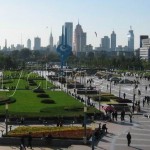Brief Market Research on Jinan
General overview of Jinan
Jinan (Chinese: 济南) is the capital of Shandong province in Eastern China. The area of present-day Jinan has played an important role in the history of the region from the earliest beginnings of civilization and has evolved into a major national administrative, economic, and transportation hub. The city, which holds sub-provincial administrative status, is located in north-western Shandong about 400 kilometres south of the national capital of Beijing. According to the 2010 Census, Jinan has a population of 6814000.
Jinan has a pool of high-quality labor resources. There are 18 universities, Shandong University (山东大学), Shandong Normal University (山东师范大学), Shandong Architectural Institute (山东建筑大学), Shandong Polytechnic University (山东轻工业学院), Shandong Jiaotong University (山东交通学院), Shandong Economic University (山东经济学院), Shandong University of Finance (山东财政学院), Shandong University of Chinese Traditional Medicine (山东中医药大学), Shandong University of Arts (山东艺术学院)), and colleges in the city where more than 200,000 students are studying. Among the 200+ research institutes in the city, 10 are national laboratories.
The most famous actress who is very well know all around the world, Gongli, is also born here in Jinan. And also the famous painter in China, Han Meilin is also from Jinan. Shu Qingchun (February 3, 1899 – August 24, 1966), better known by his pen name Lao She was a notable Chinese writer. A novelist and dramatist, he was one of the most significant figures of 20th century Chinese literature, and is perhaps best known for his novel Rickshaw Boy and the play Teahouse (茶馆). He also lived in Jinan for a period of time and he has written the famous article “ The winter of Jinan” here.
City life in Jinan: Guihe Shopping Center, Wanda Shopping Mall, Park 66
City life in Jinan is quite attractive. There are ancient spots and modern shopping malls, which will satisfy all kinds of people’s needs. Most shopping malls in Jinan are in the downtown area centered around Spring City Square (泉城广场) and Spring City Road (泉城路). Spring City Square has a music fountain, a 46,000 square meter underground shopping center and a memorial hall with statues of famous people from Shandong.
Spring City Road was rebuilt at the same time that Spring City Square was created. The government’s intended to create a modern business district and yet preserve the traditional Chinese culture. Therefore newly-built shopping malls with traditional Chinese architectural styles and modern western skyscrapers can be found side-by-side along Spring City Road. Notable retail businesses are Quancheng Bookstore – the largest bookstore of the city – and Walmart (near the western end of Spring City Road). Major shopping malls along the road are the Guihe Shopping Center (贵和商厦), the Sofitel Silver Plaza, and the Wanda Shopping Mall (万达集团). Parc 66 (济南恒隆广场) to the south of Spring City Road (opposite of Water Lily Street), opened in August 2011, is Jinan’s largest shopping mall with seven levels of retail space and a total gross floor area of 171,000 square meters. Bars like Lan Kwai Fong, Sohobar, Gossipbar(绯闻酒吧), Gold mine bar(金矿酒吧) and so on can be found in Jinan.
Primary industries: Shandong Iron and Steel Group, Sinotruk
The market base of Shandong Province is very large, so it is a good chance for foreigners and Chinese to do business here. With the shift of the Yellow River to a new bed right to the north of Jinan (in 1852) and the establishment of a railroad hub, the city became a major market for agricultural products from the productive farming regions to the north. Following the trade in agricultural goods, the city developed a textile and clothing industry, flour mills, oil presses, as well as factories producing paper, cement, and matches. In the 1950s, large iron and steel works as well as chemical factories were established around Jinan. The large metal works produce pig iron, ingot steel, as well as finished steel. In 2008, steel manufacturing was restructured with the formation of the Shandong Iron and Steel Group. In the 1970s, factories for the production of trucks and construction vehicles (Sinotruk) were added.















